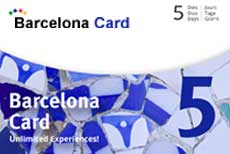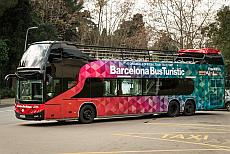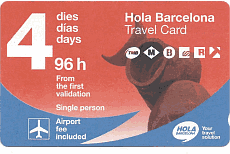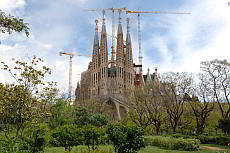Olympic and Sports Museum Joan Antoni Samaranch
A fascinating journey through the world of the Olympic Games and Sports
Sport is ... life! This shows this museum impressively. Opened in 2007, it is located next to the Olympic Stadium on Montjuïc, the local mountain of Barcelona. The goal: to introduce visitors to the history of the Olympic Games, the importance of sportsmanship and the inestimable value of sport in education and culture. With exhibits such as original jerseys of famous athletes and interactive installations, the world of sports becomes tangible in the truest sense of the word.
Our recommendation for the Olympic and Sports Museum
- With the e-bike tour and the Segway tour, you will be close to the Museum and the Olympic Sports Venues, with a fantastic view of Montjuïc
- The Hop-on Hop-off Bus is just a few steps from the museum
- Free entry with the Barcelona Card
The exhibition of the Olympic Museum
On your marks, get set, go: If you like, you can do the circuit, which leads you slightly downhill through the museum, and do some sports in a sprint - but then you would miss something exciting about the history of the Olympic Games and their disciplines. The exhibition starts in 776 BC: the year in which the first Olympic Games took place. With the realization of the games, Zeus, the god of Olympus should be honored. How the games have developed since then is clearly illustrated by information boards and exhibits.
Also the beginning of the Formula 1 and the Tour of the France is explained, as well as details about sports legends and their records. But it's not just about facts and figures: time and again, examples from history make clear what contribution sport makes in the social and cultural field and what an effective means of integration it is. Among other things, women's emancipation, the importance of sport for war veterans and the development of the Paralympics are discussed.
A big extra area in the museum is provided for the 1992 Olympic Games in Barcelona and its medial preparation. Also exciting is the private art collection of Joan Antoni Samaranch. He served for more than 20 years as chairman of the International Olympic Committee and was the driving force behind the 1992 Barcelona Olympics. After his death, the museum was named after him. His collection makes it particularly clear how closely sports, art and culture are interconnected.
Those who want to be active themselves are particularly looking forward to the end of the tour: Here, visitors can use multimedia installations to measure their reaction speed, feel the weight that professionals lift in weightlifting - or compete in the sprint against record holder Carl Lewis. Out of breath? Then there is an entertaining information film about Barcelona as a sports city, as a city in motion. Because that's exactly what our body is made of: movement.
History of the Olympic and Sports Museum Barcelona
The 1992 Barcelona Olympics were a crucial event for the city, with a great boom and formative architectural changes accordingly. In 2005, the city council decided to create a museum that would fulfil the spirit of Olympia and the sporting world as a whole. In the same year, the architects Xavier Basiana and Toni Camps started building the museum - of course not somewhere, but next to the Olympic Stadium. In 2007, the Olympic and Sports Museum was inaugurated - the first of its kind in Europe with such versatile innovative technologies and multimedia experiences. In 2010, two months after the death of Joan Antoni Samaranch, who led the International Olympic Committee for more than 20 years, the museum was named after him.
The importance of the 1992 Olympic Games for Barcelona
The death of Franco in 1975 brought profound political changes in Spain: democracy was re-established, and the Catalans were again granted more rights. Nevertheless, for almost 20 years Barcelona remained a rather dull and unattractive city. Only after winning the bid to host the Olympic Games of 1992 there was arising a mood of optimism.
The city was opened to the sea, new quarters were developed, places were redesigned and embellished. Newly built sports facilities such as the Olympic Stadium, the outdoor pool or the Port Olímpic are still used today. Also the Castell, long a symbol of the repression by the Franco-rule, was transferred as an Olympic sports place of a peaceful use.
That is why the 1992 Olympic Games are a very important milestone in the development of Barcelona - architecturally, politically and culturally. The games were a collaborative experience that touched all social classes.
Why visiting the Sports Museum is worthwhile
Already on the way to the museum, visitors can feel the sports spirit of this area: It is located right next to the Olympic Stadium and very close to other sports venues of the 1992 Barcelona Olympic Games. The museum tour takes you along important sporting events from antiquity to today and surprises you always with interesting facts. If after gaining so much information you are looking forward to become active yourself, you can compete with record holders e.g. sprinting against Carl Lewis in a large extra area thanks to interactive technology. Anyone who still had doubts about whether sport is more than just a hobby later knows: Sport is more - sport is life.
Tickets for the Olympic Museum
- Tickets for the Olympic Museum
- Barcelona Card: free admission
- Bus Turístic: hop-off in front of the museum
- Montjuïc E-Bike tour
- Segway Tour: much fun
Important information
Surroundings
Find Hotels nearby
Address
Av. De l’Estadi, 60
Phone: +34 932 925 379
Arrival
Metro: Pl. Espanya (L1, L3)
Bus Turístic: Anella Olímpica
Parking nearby
Opening times
October to March
Tuesdays to Saturdays 10:00 to 18:00
Sundays and public holidays 10:00 to 14:30
April to October
Tuesdays to Saturdays from 10:00 to 20:00
Sunday and public holidays 10:00 to 14:30
Closed: Mondays, January 1st, May 1st, December 25th and December 26th
Book your accommodation in Barcelona here! All categories.
1-5*-hotel rooms, apartments, hostels.




